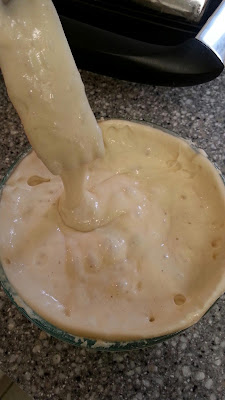Even after moving away from USA, we still feel compelled to at least bake a pumpkin pie for Thanksgiving. Outside of North America, there really isn't a market for canned pumpkins. So, in the past few years, we've mail ordered pumpkin puree from the US of A about a month in advance of Thanksgiving. To save on shipping weigh, we switched to
cartoned (tetrapak) pumpkin puree from Farmer's Market a year ago. We can vouch that there is little difference in quality. What's more, it's organic & the packaging is BPA-free :)
As in years past, I turned to the recipe on the canned/cartoned pumpkin, in addition to consulting the internet for dairy-free substitutes. To be absolutely honest, I didn't like pumpkin pie: I generally don't mind consuming a piece once every season but I would never volunteer for second helpings. But this year, for the first time, I could actually say I like it! And we (including myself) have been gradually chipping away at the pie, dreading the moment when it completely disappears. The difference, as far as I can pinpoint boils down to (1) the flaky crust which I made with my almost-5 y.o. son and (2) the extra gingery filling...
There was one other difference, which may or may not have contributed to the flavour, but is definitely a faux pas in baking... In my inattentive haste to substitute condensed milk with rice milk, I had forgotten to add any sugar to the pie filling until ~15 mins into the baking o_0 As we had ordered only one carton of pumpkin puree and not wanting to spoil my (American) hubby's Thanksgiving, I took the pie out of the oven (which was luckily still wobbly/runny) and very carefully stirred in ~1/3c of sugar, then chucked it back into the oven. To my surprise, it worked!! Although the middle of the pie was notably sweeter than the filling closer to the crust (because the edge had already partially set when I pulled it out to add the sugar), it was not awkwardly so. Oh, how I love baking adventures :)
So, here is the recipe I used:
For the pie crust, I used the recipe from my trusty baking book: the 2000 edition of "The Essential Baking Cookbook" published by Murdoch Books. I will not duplicate the recipe here, only to say that we were very careful to use cold butter and to rub the butter into the flour with our little hands and fingertips. It was hard work, but I think it made a difference. I do point out here that we use Lurpak unsalted block butter, which could very well have made a difference too...
Because it was to be used for a moist pie, we blind baked the pie crust, without any baking beads, for ~20mins. The pie did raise a bit. I pierced the air bubble immediately after removal from the oven to let the steam out; this allow pie filling to flow under the bubble.
For the
filling, I mostly followed the
recipe on the pumpkin carton, but made modifications.
Ingredients
1 (16oz) carton Farmer’s Market organic pumpkin
1.5 tsp ground ginger
3/4 tsp ground cinnamon
1/4 tsp ground nutmeg
1/4 tsp ground cloves
1/4 tsp salt
1 cup rice milk
2 tsp corn flour
2 eggs, well beaten
1/3 cup refined sugar*
1 9” blind baked pie crust
* Yes, this was the sugar that I added a quarter of an hour into baking. It was also suggested to me that I could have tried molasses rather than refined sugar because "that's how my grandma had always used".
Direction
Mix all ingredients (except the sugar) together. Pour into previously blind baked pie shell. Bake at 220ºC (425ºF) for 15 minutes. Pull out of the oven to add sugar, then reduce temperature to 180ºC (350ºF) for an additional 50-60 minutes. Don't worry if it is not completely set as it will set more as it cools (wisdom from a Yank).














